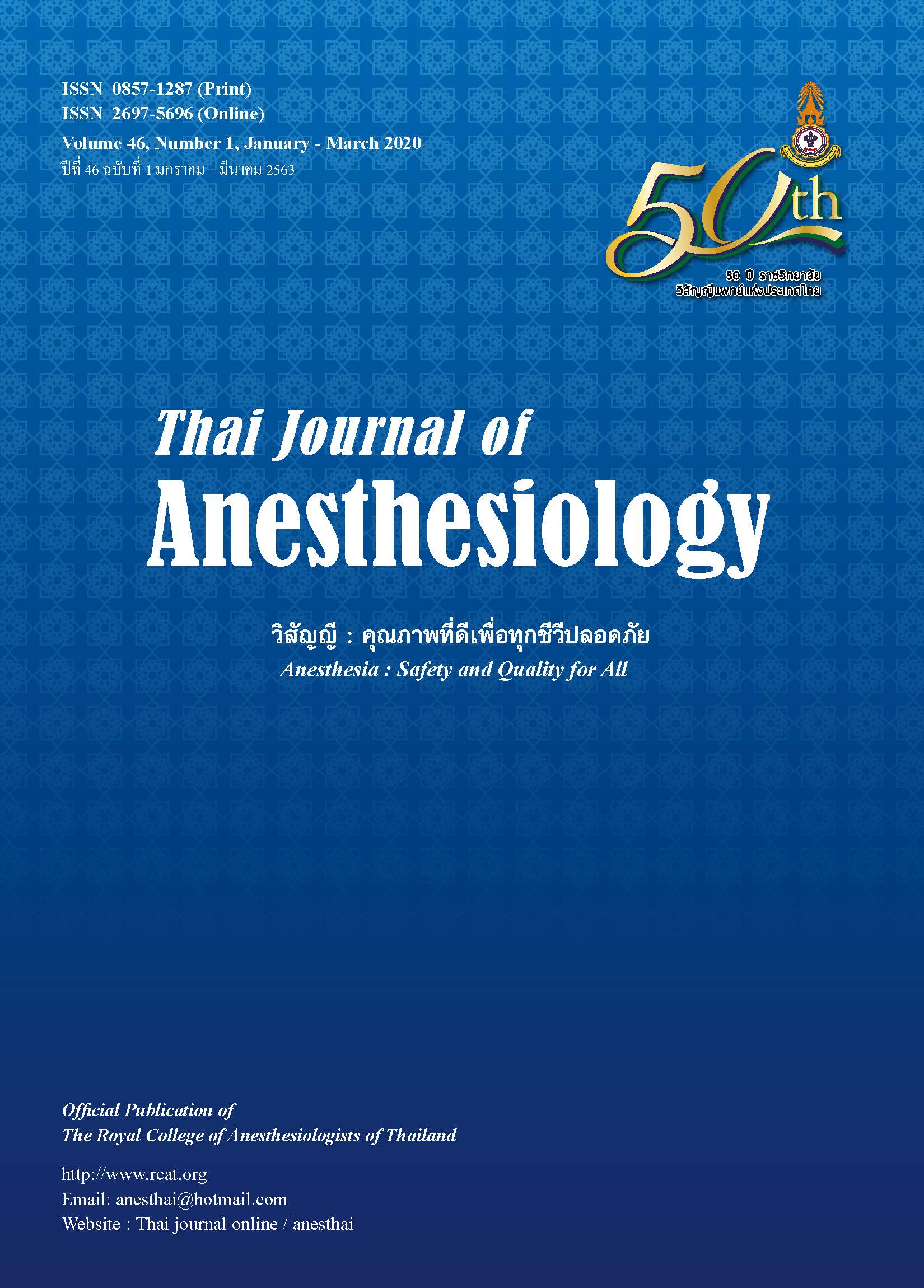Comparison of the Efficacy between Dexmedetomidine plus Morphine Patient-Controlled Analgesia (PCA) and Morphine Patient-Controlled Analgesia (PCA) Alone for Pain Control in Postoperative Valvular Heart Surgery
Main Article Content
Abstract
Introduction: Postoperative pain after valvular heart
surgery is moderate to severe pain. Morphine was
generally used, but it has undesirable dose-related side
effects. Dexmedetomidine an analgesic adjuvant may
reduce morphine used.
Objectives: To compared the efficacy between
dexmedetomidine plus morphine patient-controlled
analgesia (PCA) and morphine PCA alone postoperatively.
Methods: This randomized controlled trial assigned
32 patients undergoing valvular heart disease into
2 groups included D group (dexmedetomidine; n=16)
received dexmedetomidine after extubation with loading
dose 1 mcg/kg then infused 0.3 mcg/kg/h and P group
(placebo; n= 16); combined with PCA morphine
postoperatively in both groups. Postoperative cumulative
morphine consumption at 24 and 48 h and pain scores at
time points of 0, 6, 12, 24 and 48 h were recorded.
Results: The cumulative morphine consumption was
not statistically significant in both groups within 48 h
postoperatively (D vs. P group = 16.94 ± 7.56 mg vs.
15.00 ± 6.46 mg, 95%CI -2.05-2.55, p-value = 0.826).
The D group had numeric rating scale (NRS) value at rest
lower than P group significantly at 12 h postoperative
(0.06 ± 0.25 and 0.88 ± 1.50, mean different = -0.81,
95%CI -1.59 to -0.04, p-value = 0.041) and 24 h
postoperative (0 and 0.44 ± 0.81, mean different = -0.44,
95%CI -0.85 to -0.02, p-value = 0.040). The NRS at rest
in the other time and on movement in any time did not
different between groups.
Conclusion: Dexmedetomidine 0.3 mcg/kg/h cannot
decrease cumulative morphine consumption within 48 h
postoperatively as an adjunct to morphine PCA.
Article Details
References
morphine and dexmedetomidine intravenous patientcontrolled
analgesia method to control pain after open
cardiac surgery: A randomized control trial. Arch Crit Care
Med 2015;1(3):e6453. doi: 10.17795/accm-6453.
2. Abd Aziz N, Chue MC, Yong CY, et al. Efficacy and safety of
dexmedetomidine versus morphine in post-operative cardiac
surgery patients. Int J Clin Pharm. 2011;33:150-4.
3. Wang X, Liu W, Xu Z, et al. Effect of dexmedetomidine alone
for intravenous patient-controlled analgesia after gynecological
laparoscopic surgery. Medicine (Baltimore) 2016;95:1-7.
4. Kim SY, Chang CH, Lee JS, et al. Comparison of the efficacy
of dexmedetomidine plus fentanyl patient-controlled
analgesia with fentanyl patient-controlled analgesia for pain
control in uterine artery embolization for symptomatic fibroid
tumors or adenomyosis: A Prospective, Randomized Study.
J Vasc Interv Radiol 2013;24:779-86.
5. Highlights of prescribing information (dexmedetomidine
hydrochlo-ride) [Internet]. 2013 [cited 2018 Feb 19].
Available from: https://www.accessdata.fda.gov/drugsatfda_
docs/label/2013/021038s021lbl.pdf
6. Naik BI, Nemergut EC, Kazemi A, et al. The effect of
dexmedetomidine on postoperative opioid consumption and
pain after major spine surgery. Anesth Analg 2016;122:1646-53.
7. Tang C, Xia Z. Dexmedetomidine in perioperative acute pain
management: a non-opioid adjuvant analgesic. J Pain Res.
2017;10:1899-904.
8. Gertler R, Brown HC, Mitchell DH, et al. Dexmedetomidine:
a novel sedative-analgesic agent. Proc Bayl Univ Med Cent.
2001;14:13-21.
9. Sadhasivam S, Boat A, Mahmoud M. Comparison of patientcontrolled
analgesia with and without dexmedetomidine
following spine surgery in children. J Clin Anesth 2009;21:
493-501.


